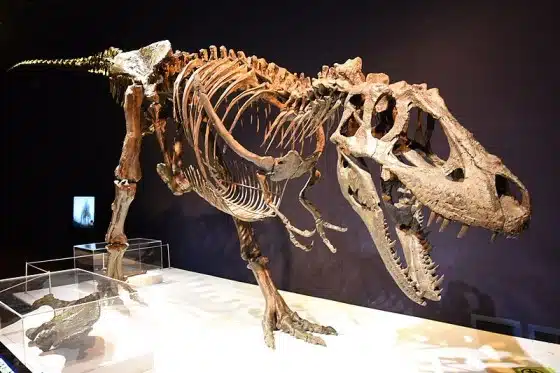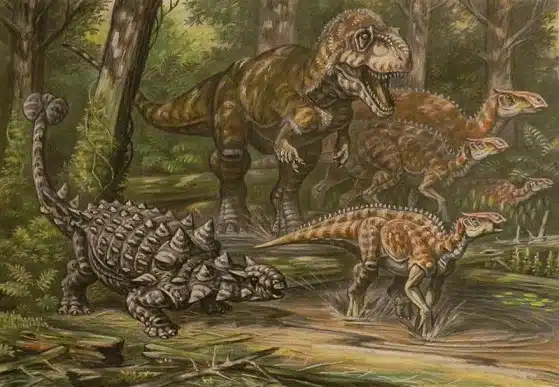Daspletosaurus, whose name aptly translates to “frightful lizard,” was a force to be reckoned with in the Late Cretaceous period. A member of the tyrannosauridae family, Daspletosaurus was a fearsome theropod predator. Its large size, powerful jaws, and sharp teeth made it one of the apex predators of its time. But beyond its fearsome exterior, Daspletosaurus was a product of its environment that perfectly adapted to the challenges of its era.
Daspletosaurus Key Facts
| Keyword | Fact |
|---|---|
| Daspletosaurus pronunciation | daz-PLEE-toh-SOR-us |
| Meaning of name | Frightful lizard |
| Group | Theropod |
| Type Species | Daspletosaurus torosus |
| Diet | Carnivore |
| When it Lived | 83.5 to 66.0 MYA |
| Period | Late Cretaceous |
| Epoch | Judithian to Late/Upper Maastrichtian |
| Length | 29.5 ft |
| Height | 10.8 ft |
| Weight | 2.8 tons |
| Mobility | Moved on two legs |
| First Discovery | 1921 by Charles Mortram Sternberg |
| Location of first find | Alberta, Canada |
| First Described by | 1970 by Dale Russell |
| Holotype | CMN 8506 |
Daspletosaurus Taxonomy and Timeline

The name Daspletosaurus, meaning “frightful lizard,” is a fitting moniker for this intimidating dinosaur. The name is derived from the Greek words “daspleto,” meaning “to frighten,” and “sauros,” meaning “lizard.” This name reflects the fearsome nature of this dinosaur as one of the top predators of its time.
It belongs to the taxonomic group of Theropoda. A group of bipedal dinosaurs that includes some of the most fearsome predators in dinosaur history–including the infamous Tyrannosaurus rex. Within this group, it is part of the Tyrannosauridae family, a family of large predatory dinosaurs characterized by their large size and powerful jaws. Its type species is Daspletosaurus torosus. Moreover, there are two other subspecies belonging to this genus as well: D. horneri and D. wilsoni.
This carnivorous dinosaur lived in North America during the Late Cretaceous period. This was a time of significant change in the earth’s history as the continents slowly took on their modern shapes and the first flowering plants began to appear.
Discovery & Fossil Evidence
The first fossils of Daspletosaurus were discovered in 1921 by Charles Mortram Sternberg in Alberta, Canada. These initial finds were significant, providing the first glimpse into this fearsome predator. Since then, additional Daspletosaurus fossils have been found in Montana, USA that further expand our understanding of this dinosaur.

Fossils of this dinosaur are relatively rare but the specimens that have been found are remarkably well-preserved. These fossils include several nearly complete skeletons, which have provided invaluable insights into the dinosaur’s physical characteristics and lifestyle. Notable specimens include a well-preserved skull and a nearly complete skeleton found in Montana.
Daspletosaurus Size and Description
This predator was a formidable creature, even among the fearsome tyrannosaurids. Its size and physical characteristics made it one of the most feared predators of its time.
It was a large, bipedal predator. Its body was built for power with a heavy, robust build, a large skull, and powerful jaws filled with sharp teeth. Its arms were short and strong with two clawed fingers on each hand. The dinosaur’s long, heavy tail balanced its large head and torso and allowed it to move quickly despite its size.
Size and Weight of Type Species

Daspletosaurus was a large dinosaur, with adults reaching lengths of up to 29.5 feet and weights of up to 2.8 tons. However, these estimates are based on the largest known specimens, and the average size may have been slightly smaller. Despite its large size, it was likely a fast and agile predator capable of quick bursts of speed when hunting prey.
The Dinosaur in Detail
Daspletosaurus was a marvel of prehistoric engineering. Its robust build and powerful jaws made it a daunting predator while its keen senses and agile movements allowed it to thrive in the diverse ecosystems of the Late Cretaceous period.
Its most distinguishing feature was undoubtedly its large, powerful jaws. These jaws were filled with sharp, serrated teeth that were perfect for tearing through the flesh of its prey. The dinosaur’s teeth were continually replaced throughout its life, ensuring that it always had a fresh set of deadly weapons at its disposal.
It also had a number of unique adaptations that set it apart from other tyrannosaurids. For example, it had a unique arrangement of openings in the skull known as fenestrae, which may have helped to reduce the weight of its large head. Additionally, it had a unique pattern of scales on its skin that may have served a variety of functions, from thermoregulation to display.
Daspletosaurus in its Natural Habitat

This dinosaur lived in a world very different from our own. The Late Cretaceous period was a time of dramatic change, with the continents slowly taking on their modern shapes and the first flowering plants beginning to appear. North America was no exception to these changes–it was still split into two paleocontinents by a vast interior seaway. The Daspletosaurus could be found on the western paleocontinent known as Laramidia.
It was a carnivore and its diet likely consisted of both small and larger herbivorous dinosaurs. Its powerful jaws and sharp teeth would have allowed it to take down even the largest and most formidable prey. The dinosaur’s large size and powerful build suggest that it was a top predator in its ecosystem that dominated the food chain.
It likely lived in a variety of environments inhabiting both forests and open plains. Its robust build and powerful legs would have allowed it to navigate these diverse landscapes with ease. The dinosaur’s keen senses and agile movements would have made it a successful hunter capable of tracking and taking down prey in a variety of environments.
Interesting Points about Daspletosaurus
- This was one of the last large tyrannosaurids before the extinction of the dinosaurs.
- Despite its fearsome reputation, some evidence suggests that it may have lived in family groups.
- It had a unique arrangement of openings in the skull, known as fenestrae, which may have helped to reduce the weight of its large head.
- It had a unique pattern of scales on its skin. These may have served a variety of functions, from thermoregulation to display.
Contemporary Dinosaurs
Daspletosaurus shared its world with a captivating group of other Laramidian dinosaurs. Among these were Coronosaurus and Saurolophus as well as Dineobellator to name but a few. Each playing their own unique role in the intricate ballet of survival that unfolded in this ancient ecosystem.
Coronosaurus was a creature of notable stature that may have been a competitor for resources. Its size, while not rivaling that of Daspletosaurus, could have made it a noticeable presence. The distinctive crest of Saurolophus, on the other hand, might have been a common sight. This herbivore could be spotted grazing in the same lush landscapes. Its diet would have set it apart from the carnivorous Daspletosaurus, yet the two could have crossed paths in the course of their daily lives.
The smaller yet agile Dineobellator adds another layer of complexity to this prehistoric scene. This swift predator might have been an occasional rival to Daspletosaurus that competed for the same prey. Yet, despite their potential rivalries and differences these creatures were all part of a shared environment, their lives intertwined in ways that shaped the course of their evolution.
List Of All Dinosaurs
We have created a list of all dinosaurs we have covered here, sorted across the seven main groups of dinosaurs. We also include information about their type of diet, (omnivore, herbivore or carnivore) and the time they lived.
Frequently Asked Questions
It was a carnivore whose diet likely consisted of large herbivorous dinosaurs.
This was a large dinosaur, with adults reaching lengths of up to 29.5 feet and weights of up to 2.8 tons.
The Daspletosaurus likely lived in a variety of environments, from forests to open plains of western North America.
It had a unique arrangement of openings in the skull, known as fenestrae, which may have helped to reduce the weight of its large head. Additionally, it had a unique pattern of scales on its skin that may have been used for thermoregulation or display behaviors.
Despite its fearsome reputation, some evidence suggests that it may have lived in family groups.
It lived during the Late Cretaceous period, around 83.5 to 66.0 million years ago
Sources
The information in this article is based on various sources, drawing on scientific research, fossil evidence, and expert analysis. We aim to provide a comprehensive and accurate overview of the Daspletosaurus. However, please be aware that our understanding of dinosaurs and their world is constantly evolving as new discoveries are made.
- https://www.researchgate.net/publication/344187485_A_Subadult_Frontal_of_Daspletosaurus_torosus_Theropoda_Tyrannosauridae_from_the_Late_Cretaceous_of_Alberta_Canada_with_Implications_for_Tyrannosaurid_Ontogeny_and_Taxonomy
- https://www.sciencedirect.com/science/article/abs/pii/S0195667119303611
- https://www.nature.com/articles/srep44942
Article last fact-checked: Joey Arboleda,06-14-2023
Featured Image Credit: I,Steveoc 86, CC BY-SA 2.5, via Wikimedia Commons
